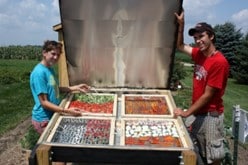A deep dive into the world of food dehydration
Last Updated on July 28, 2024
Food dehydration is a preservation technique that reduces moisture content in foods to extend shelf life. Not only is food dehydration available to industries but also accessible to consumers, who can easily purchase food dehydrators from stores. The process can take four to ten hours and examples of dried foods include fruit leathers or rolls, herbs, and beef jerky.
Food dehydration, however, does have limitations as dairy and high-fat foods are prone to bacterial growth and rapid spoilage and thus are unsuitable for dehydration. Despite this limitation, food dehydration has numerous advantages for manufacturers and consumers. It has been improved over the years through various techniques such as freeze drying, solar drying, and the use of food dehydrators.
Benefits of Food Dehydration
While primarily focused on extending shelf life, food dehydration offers additional benefits. It reduces both the weight and volume of food, lowering packaging costs and transportation fees. Moreover, the concentrated texture and flavor enhance culinary experiences. Additionally, it provides convenience for campers or astronauts with instant meal options, such as instant noodles, and individuals in remote areas lacking refrigeration or freezer storage.

Fruits are common foods which are dehydrated
One prevalent misconception about dried foods is that their nutritional value differs significantly from fresh products. While some water-soluble vitamins may diminish during drying, dehydrated foods retain most of their nutritional content. It is important to note that refrigeration of fresh produce can also lead to nutrient loss. Another myth is that dried foods are inherently unhealthy and fattening. However, it is only through excessive consumption rather than dehydration itself that may contribute to weight gain. For instance, a half cup of raisins contains 250 calories, whereas the same portion of fresh grapes has only 50 calories. Additionally, due to the reduced volume resulting from water loss, individuals may feel hungry after consuming dried snacks. In short, dried foods may not be the best weight loss foods, and consumers should select foods high in water content and volume, such as leafy greens, to feel more satiated. Due to the risks of colour variations or structural damage, freeze-drying or lyophilization is not popular in the food industry. Despite its disadvantages, freeze-drying is a popular method for producing space food. The National Aeronautics and Space Administration (NASA) supports freeze-dried foods such as nuts, fruits, and condiments. To accomplish this method, the process entails freezing, sublimation and desorption. The products are cooled below the triple point, remaining in their original configuration. The triple point is where the gas, liquid and solid phases coexist in equilibrium and where the frozen food is below this temperature to remain solid. The ice sublimates into vapour to create lightweight products with porous structures. Finally, desorption occurs at a reduced pressure to continue heating the product to release water molecules from the porous structure. Subsequently, water vapour is released from the pores and removed until 90-95% of water is removed. Cereal is a commonly used for freeze dried fruits Solar drying is an alternative method to freeze-drying. The most commonly used type of solar dryer found on farms is the natural convection dryer. Solar dryers are made up of solar collectors, drying bins, and solar chimneys. When the sun shines on the transparent glass of the solar collectors, the black metal absorber heats the inlet air. The food is then arranged on trays placed inside the drying bins, where warm air dries the food in the insulated chamber. After drying, the air vents at the solar chimney, leaving the food pasteurized and dried at temperatures ranging from 54 to 82°C. Unlike sun drying, solar drying is more beneficial in maintaining food safety as the closed design of the solar dryer minimizes the risks of contamination and vulnerability to environmental contaminants such as dust. Moreover, solar dryers may work even in cloudy or humid weather. Example of a solar food dryer [Image Source: West Madison Agricultural Station]Common Myths about Food Dehydration
Methods of Food Dehydration
Freeze-Dried Foods
Solar Drying
Conclusion
In summary, food dehydration offers both preservation and culinary benefits, debunking common misconceptions about its nutritional value. Freeze-drying and solar drying are some common methods. Freeze-drying produces lightweight products and solar drying prevents contaminants from its closed design. As food dehydration techniques continue to evolve, consumers should be aware of its importance in sustaining the global food supply.

About the Author: Hi! I am Bertina Do, a first-year food science student attending the University of Guelph. I have a fascination with food chemistry and molecular gastronomy.




leave your comment